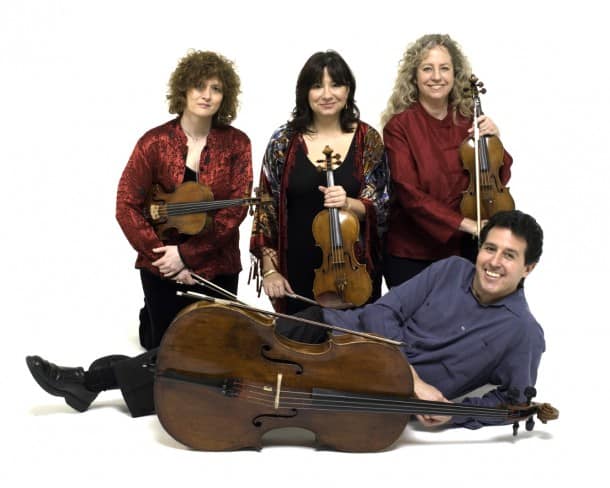"Each an Experiment"


- Bettina Mussumeli and Susan Freier, violins
- Jodi Levitz, viola
- Stephen Harrison, cello
- PROGRAM:<br/>
- Wolfgang Amadeus Mozart, String Quartet in E-flat Major, K.428<br/>
- Henry Cowell, String Quartet No. 3, Mosaic<br/>
- Felix Mendelssohn, String Quartet in F minor, Op. 80
The Ives Quartet is at it again: having exhausted the Haydn opus 50 quartets, they’ve moved on to Mozart’s six Haydn quartets. In doing so, the group has traversed the short distance from the father of string quartets, to his dear friend, who composed 23 of the same, six of which he referred to as “his children” in his dedication to Haydn. The program of this concert moves easily from Mozart’s String Quartet in E Flat Major, K. 428, to Henry Cowell to Mendelssohn’s String Quartet No. 6 in F Minor. Small similarities between the Mozart and the Mendelssohn pieces make this a delicious programmatic progression.
Cellist Stephen Harrison noted that the first movement of the Mozart piece starts ambiguously, and the second theme of the first and the fourth movements have a strange improvisatory quality. This is true enough, as the opening has a smoky, windy quality, whose parameters are firmly set by the arcing octave stretch in the first measure. However, Harrison could just as easily have said that this is Mozart for those who can’t countenance the ornate late Baroque quality that makes Mozart so enjoyable for the rest of us. This is Mozart with both feet in the classical world.
The IQ seems fascinated with Henry Cowell, as they performed his United Quartet in their 2012-2013 season. However, whereas the United Quartet is one of Cowell’s more accessible pieces, the Mosaic Quartet (1935) is less so. According to Cowell, its five stand-alone movements can be played in any order, as many times as the musicians see fit. Harrison characterizes these short movements as “sonically adventurous.” For example, just when you’re wondering how the first movement (or what I took to be the first movement, given the unfettered organization of the piece) can possibly resolve, it ends, with a feeling as unequivocal as the blackout ending of the Sopranos’ final show. The third movement begins with the violins and viola sounding all the world like underwater dolphins signaling to a far-away mate, until Harrison provides a melody line. The keening high notes reappear in subsequent movements, sounding a bit like a distant fire truck alarm. One of the most gripping moments was when violinist Bettina Mussumeli played extremely softly, just over Jodi Levitz on viola. The oddity of such insistent pianissimo remained long after the piece ended.
The rich romanticism of the Mendelssohn is immediately on display from the very first notes of his String Quartet No. 6 in F. Minor. This was the last work he wrote, shortly after the death of his sister Fanny and two months before his own demise. Technically, it’s an ambitious work, almost an athletic one, which puts the enormous talents of the Ives Quartet on display. The first moment begins with big drama; Mussumeli attacks the demanding frenetic passages that alternate with the more lyrical ones with a pointedness that resonates long after the piece has ended.
The second movement of this balances the intense sturm und drang against an ironically plucky triplet of descending notes. It is these notes that echo a series of triplets (E♭-G-E♭, D-F-D, C-E♭-C) that recur during the first movement of the Mozart quartet. In both instances, they signal the end of a longer gesture. The first time round in the Mozart, it’s a form of punctuation. The second time around in the Mendelssohn, it’s an ironic statement. The Ives Quartet has taken the audience the whole way.
The Ives Quartet will be performing these works again on Sunday, February 23rd at the Old First Church in San Francisco. They will be offering another Music in Context Sunday Salon on March 9th.



